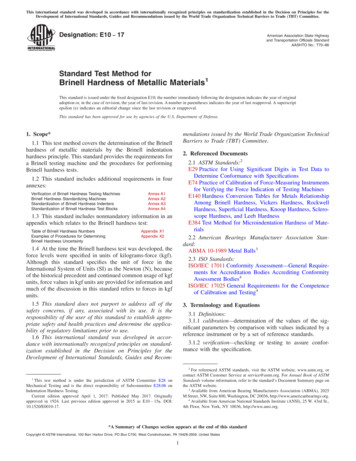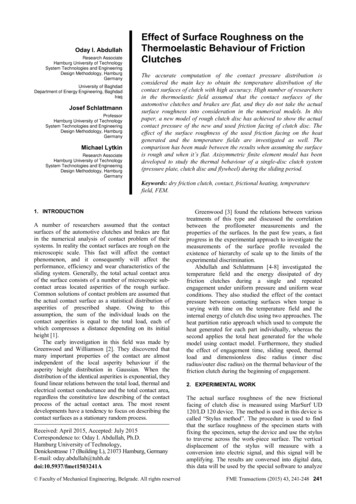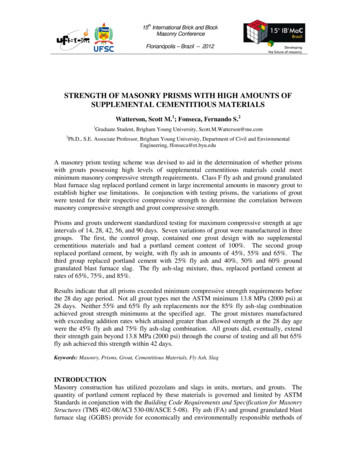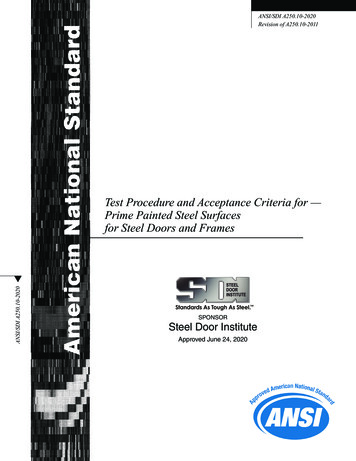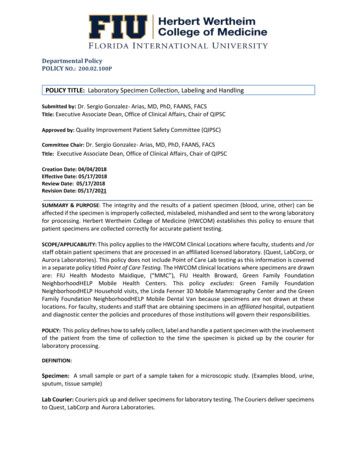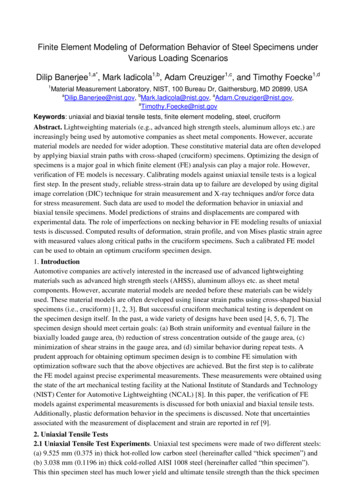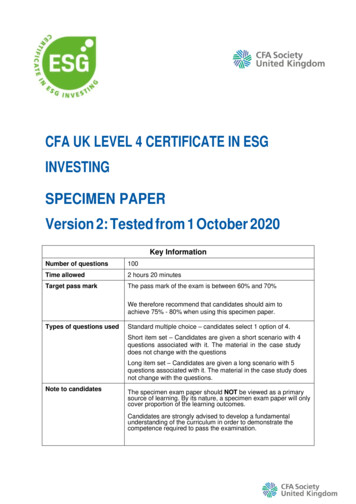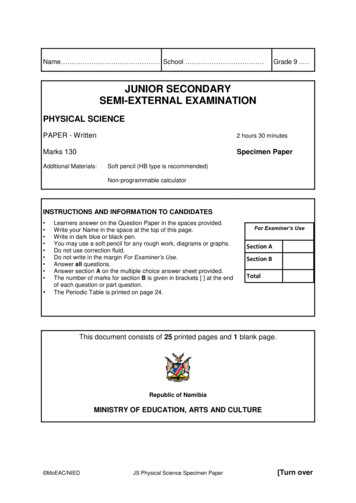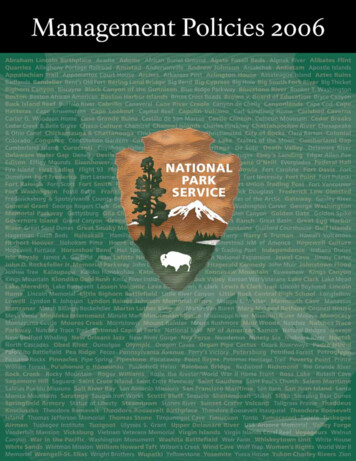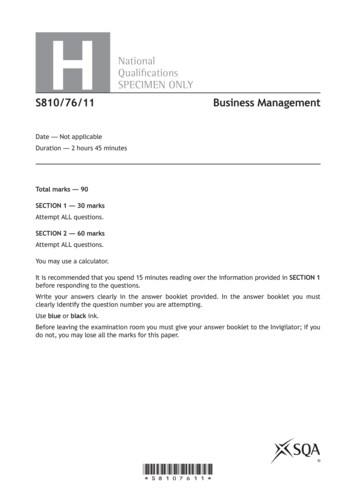
Transcription
HNationalQuali cationsSPECIMEN ONLYS810/76/11Business ManagementDate — Not applicableDuration — 2 hours 45 minutesTotal marks — 90SECTION 1 — 30 marksAttempt ALL questions.SECTION 2 — 60 marksAttempt ALL questions.You may use a calculator.It is recommended that you spend 15 minutes reading over the information provided in SECTION 1before responding to the questions.Write your answers clearly in the answer booklet provided. In the answer booklet you mustclearly identify the question number you are attempting.Use blue or black ink.Before leaving the examination room you must give your answer booklet to the Invigilator; if youdo not, you may lose all the marks for this paper. *S8107611*
SECTION 1 — 30 marksRead ALL the following information and attempt ALL the questions that follow.Toyota — ‘Always a Better Way’Toyota is one of the world’s biggest car companies, selling around 10 million vehicles in 2017.Toyota offers a range of cars for different market segments, including a luxury top-end brandcalled ‘Lexus’. The Toyota website states that it ‘has a car for everyone’ in its product portfolio. Asample of the portfolio is shown in Exhibit 2.The global market for cars is expected to continue toincrease. Sales are predicted to rise, driven by the globaleconomic recovery, falling fuel prices, low interest rates andhigher household disposable income.Despite its Sports Utility Vehicles (SUVs) being popular in theUSA, Toyota may face a fall in demand as the currentPresident wants consumers to purchase American cars.Production developmentToyota is famous for its lean production techniques such as just-in-time (JIT). Toyota also utilisesits staff very effectively. Through quality circles and a suggestion system, team members strive toachieve Toyota’s quality management principle of continuous improvement. More than 90,000employee suggestions are adopted each year, with some individual team members havingcontributed more than 1,000 suggestions.While Toyota, like any modern day car manufacturer, has a capital-intensive approach usingautomated production lines, it places a high importance on its employees and carries outextensive workforce planning. This ensures it has sufficient staff, whilst being aware of the effectsof an increasingly mechanised approach on staff numbers. Toyota has launched its own academyto provide learning and skills development covering all aspects of its business.While an autocratic leadership style is common in manufacturing, Toyota regards all employees asmembers of the team. All staff are considered important contributors and are given a high level ofautonomy.Leaders in ‘green’ carsToyota’s first venture into hybrid technology, which enables cars to run on both fuel andelectricity, was the Toyota Prius model.A hybrid vehicle has two engines, one electric and one conventional fuel, ie petrol or diesel.Unlike an electric car, a hybrid vehicle recharges its own battery on the move when it is beingdriven by the conventional engine. There is no need to look for a charging point for this type ofcar or wait for one to become free. It is both fuel efficient and environmentally-friendly since ithas significantly low carbon emissions. Venturing into hybrid technology has helped Toyota’scustomers reduce their carbon footprint.page 02
In order to develop this eco-friendly model further, Toyotarolled out the Prius Plug-in hybrid. The Prius Plug-in can becharged at home or at a charging point for additionalpower. This can be completed in two hours. The fuel tank ison the left side and a plug-in socket for recharging is on theright side. As a result, the hybrid is more fuel efficient,making it more attractive to the consumer.Star Safety SystemThe Toyota Prius Plug-in also excels in terms of safety. The carmaker’s Star Safety System ensuresthat accident avoidance features are in place, such as a system to assist with emergency brakingand a camera for reversing.With Toyota’s commitment to continuous improvement, safety, environmental awareness and leanproduction, it is clear to see why its marketing slogan is ‘Always a Better Way’.Further informationExhibit 1Toyota’s SWOT analysisStrengthsWeaknesses high worldwide car sales large product portfoliolack of presence in emerging markets, suchas China and India an innovator in ‘green’ car development numerous vehicle recalls due to faults extensive workforce planning system highly recognisable brandOpportunitiesThreats changing customer attitudes towards‘green’ cars competition from General Motors and VWgroup falling fuel prices rising raw material prices global economic recovery natural disasters in Japan fluctuating exchange rates[Turn overpage 03
Exhibit 2Product portfolio sample 2017ModelMarketPriceLuxury 73,375Eco-friendly 24,115Economy 8,995Lexus GSFToyota PriusToyota AYGOExhibit 3Toyota’s ratio analysisRatio20162017Current Ratio1·13:11·03:1Gross Profit Percentage20·41%17·62%Return on Equity Employed6·27%4·82%page 04
MARKSThe following questions are based on ALL the information provided and on knowledgeand understanding you have gained whilst studying the course.1.(a) Describe the benefits to Toyota of maintaining a product portfolio, as shown inExhibit 2.3(b) Justify the methods Toyota uses to ensure quality.4(c) Explain the advantages of Toyota’s inventory management system, as identifiedin the case study.4(d) (i) Describe 3 steps that Toyota may take in its workforce planning.34(ii) Explain the reasons for Toyota’s choice of production method.(e) Explain the impact on Toyota of the external factors listed in the SWOT analysis,as shown in Exhibit 1.(f)5Describe possible reasons for Toyota’s trends in the following ratios, as shown inExhibit 3: Current Ratio Return on Equity Employed.4(g) Justify, using examples from the case study, the methods Toyota has used todemonstrate Corporate Social Responsibility.[Turn overpage 053
SECTION 2 — 60 marksMARKSAttempt ALL questions2.(a) Describe the features of Maslow’s motivation theory.5(b) Explain the benefits of positive employee relations.3(c) Describe the impact of current employment legislation on organisations.4(d) Describe the following appraisal methods:3.4.5. one-to-one 360-degree peer-to-peer.3(a) Discuss the sources of finance available to a public limited company (plc).4(b) Explain the benefits of preparing a cash budget.5(c) Compare the use of functional grouping with product grouping.4(d) Justify the use of spreadsheets in the finance department.2(a) Describe examples of conflict that may arise between different groups ofstakeholders.2(b) Discuss the methods of growth that can be used by organisations.8(c) Distinguish between a strategic decision and a tactical decision.2(d) Describe 3 internal constraints that can make decision making difficult.3(a) Describe the following elements of the extended marketing mix: people process physical evidence.6(b) Discuss the use of centralised warehousing.3(c) Describe the following pricing strategies: skimming penetration discrimination.6END OF SPECIMEN QUESTION PAPERpage 06
Acknowledgement of CopyrightCase studyUse of Toyota (GB) PLC name and as reference in Appendix 1 are reproduced by kindpermission of Toyota (GB) PLC.Case Study Picture 1Mrs ya/Shutterstock.comCase Study Picture 2Steve Lagreca/Shutterstock.comExhibit 2 Luxury carEd Aldridge/Shutterstock.comExhibit 2 Eco-friendly carArt Konovalov/Shutterstock.comExhibit 3 Economy carDong liu/Shutterstock.compage 07
HNationalQuali cationsSPECIMEN ONLYS810/76/11Business ManagementMarking InstructionsThese marking instructions have been provided to show how SQA would mark thisspecimen question paper.The information in this publication may be reproduced to support SQA qualifications onlyon a non-commercial basis. If it is reproduced, SQA should be clearly acknowledged asthe source. If it is to be used for any other purpose, written permission must be obtainedfrom permissions@sqa.org.uk.Where the publication includes materials from sources other than SQA (ie secondarycopyright), this material should only be reproduced for the purposes of examination orassessment. If it needs to be reproduced for any other purpose it is the user’sresponsibility to obtain the necessary copyright clearance.
General marking principles for Higher Business ManagementAlways apply these general principles. Use them in conjunction with the detailed markinginstructions, which identify the key features required in candidates’ responses.(a)Always use positive marking. This means candidates accumulate marks for thedemonstration of relevant skills, knowledge and understanding; marks are notdeducted for errors or omissions.(b)If a candidate response does not seem to be covered by either the principles ordetailed marking instructions, and you are uncertain how to assess it, you mustseek guidance from your team leader.(c)For describe questions, candidates must make a number of relevant, factual pointsup to the total mark allocation for the question. These should be key points; theydo not need to be in any particular order. Candidates may provide a number ofstraightforward points or a smaller number of developed points, or a combinationof these.Up to the total mark allocation for this question:(d) award 1 mark for each accurate relevant point of knowledge award a second mark for any point that is developed from the point ofknowledge.For explain questions, candidates must make a number of points that relate causeand effect and/or make the relationships between things clear, for example byshowing connections between a process/situation. These should be key reasons andmay include theoretical concepts. There is no need to prioritise the reasons.Candidates may provide a number of straightforward reasons or a smaller numberof developed reasons, or a combination of these.Up to the total mark allocation for this question: award 1 mark for each accurate relevant point of reasonaward a second mark for any other point that is developed from the samereason.For each relevant point of reason candidates must give a point of identification anda point of explanation to gain a mark. This is exemplified in the markinginstructions, a dash (—) is used to show the two parts of the response.(e)For compare questions, candidates must demonstrate knowledge andunderstanding of similarities and/or differences between things, methods orchoices. The relevant comparison points could include theoretical concepts.page 02
Up to the total mark allocation for this question: (f)award 1 mark for each accurate point of comparison.For discuss questions, candidates must make a number of points that communicateissues, ideas, or information about a given topic or context that will make a casefor and/or against. They do not always need to give both sides of the debate intheir response.Up to the total mark allocation for this question: award 1 mark for any accurate point of knowledge that is clearly relevant award a second mark for any point that is developed from the point ofknowledge.Where a mark is available for the development of a response this is exemplified in themarking instructions, a hollow bullet point is used to show the developed response.page 03
Marking instructions for each questionQuestionExpected response1.Responses could include:(a)MaxAdditional guidancemark3Candidates must describe at least 2 benefits to gainfull marks. risk is spread over different markets increased profits from selling different modelsAward 1 mark for each valid description. newer models can replace those at the end of theproduct life cycleAward up to 2 marks for any one benefit. a range of products increases brand awareness able to meet the needs of different market segments.Accept appropriate reference to Boston Matrix.Accept any other suitable response.page 04
Question(b)MaxAdditional guidancemarkExpected response4Responses could include:Quality circles/suggestion system using members of production staff to suggestimprovementso Candidates must justify at least 2 methods to gain fullmarks.Award 1 mark for each valid justification.increases staff motivationAward up to 3 marks for any one method.workers doing the job often have a better idea thanmanagement of how to improveworkers have suggested the ideas themselves so itreduces staff resistance to change.Quality management strong focus on customer, leads to greater customersatisfaction commitment from all staff, should ensure a high-qualityproduct quality checked at all stages, means fewer products notbeing up to standard highly skilled/trained staff, results in good customerservice quality inputs, leads to a high-quality product or service zero error tolerance, results in less wastage high-quality products, lead to loyal customers high–quality products, result in the organisation havinga good reputation continual improvement, means the organisation staysahead of the competition.page 05Accept any other suitable response.
Question(c)MaxAdditional guidancemarkExpected response4Responses could include: supplies are ordered only when they are needed forproduction — which means there is no wastage ofinventory no money is tied up in inventory — which improves cashflow no large warehouse is required — saving on relatedcosts, for example rent/security strong relationships are formed with suppliers — whichmakes suppliers more responsive to changing externalfactors/demand obecause inventory can be ordered in, at the exactmoment trends are identifiedotherefore inventory is not surplus to requirement iftrends in car purchases changethere is less chance of theft by staff or customers —because it is easier to supervise minimal inventory.page 06Candidates must explain at least 2 advantages to gainfull marks.Award 1 mark for each valid explanation.Award up to 3 marks for any one advantage.The method of inventory management system mustcome from the case study — just-in-time (JIT).Accept any other suitable response.
Maxmark Additi
With Toyota’s commitment to continuous improvement, safety, environmental awareness and lean production, it is clear to see why its marketing slogan is ‘Always a Better Way’. Further information Exhibit 1 Toyota’s SWOT analysis Strengths high worldwide car sales large product portfolio an innovator in ‘green’ car development


